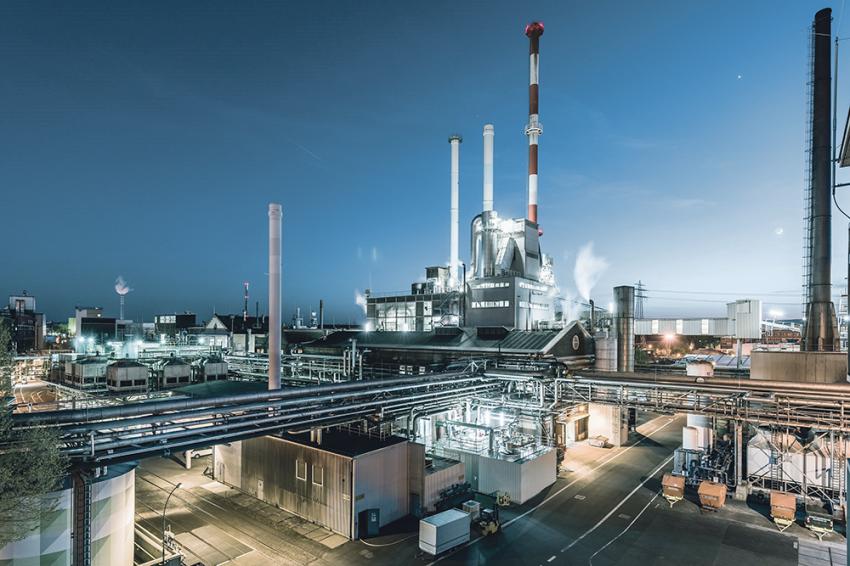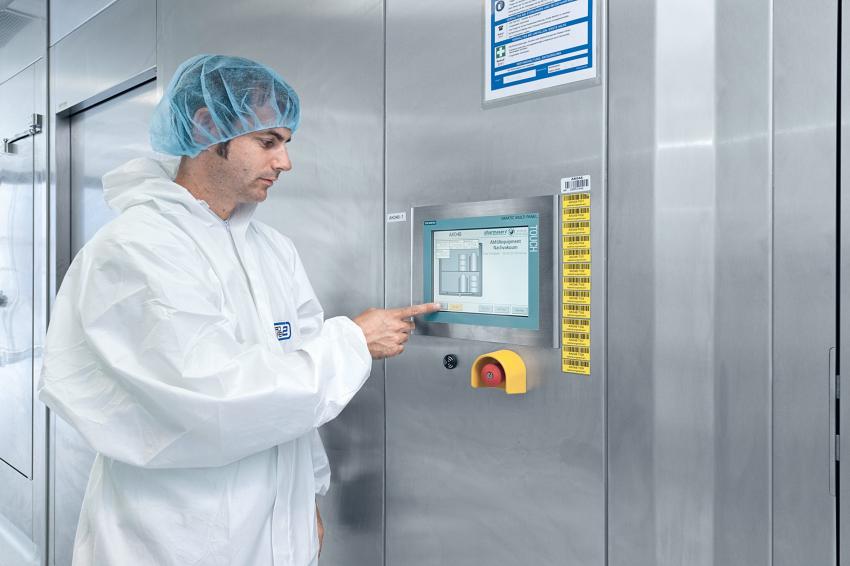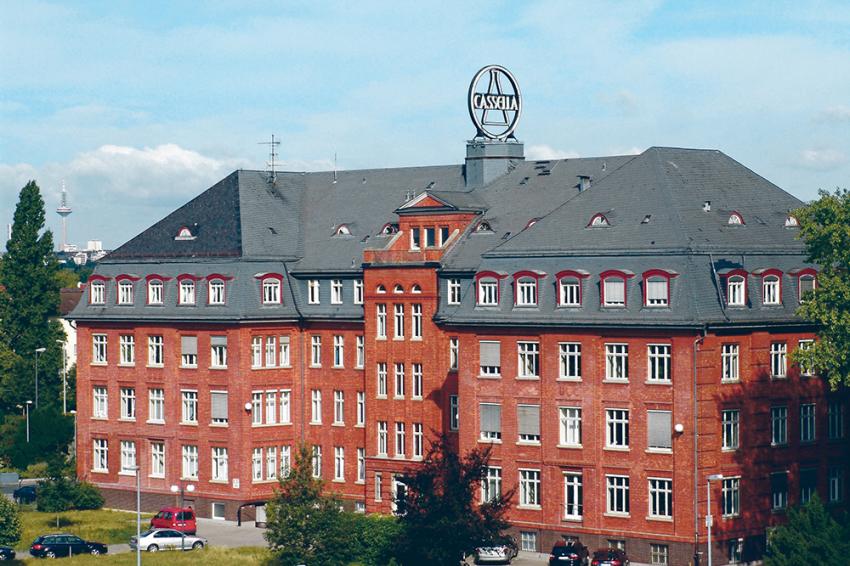In The Right Place
Hesse’s Industrial Parks Focus on Competitive Position
The chemical and pharmaceuticals industry of the state of Hesse in Germany has been true to its traditions. The locations that witnessed the development of this sector have evolved today into industrial parks for enterprises active in a diversity of fields.
The chemical and pharmaceuticals industry has long been a presence in Hesse. Now industrial parks have sprung up on the sites of globally prominent firms like the former Hoechst in Frankfurt or Behringwerke in Marburg. These industrial parks provide the companies that settle within them with state-of-the-art infrastructure and services geared to each firm’s particular needs. They free the firms to focus on securing their competitive position in an era of globalization.
The industrial parks in the Hanau-Wiesbaden-Marburg triangle surrounding Frankfurt profit from the natural benefits of this particular location.
“This central location within Germany and Europe, with Frankfurt Airport as the international hub, argues conclusively for Hessen as an economically pivotal location,” said Dr. Rainer Waldschmidt, CEO of Hessen Trade & Invest, the economic development organization of the state of Hesse.
Optimal access to all of Hesse’s industrial parks, most of which have their own ports and rail connections, facilitates international cooperation and ensures maximum efficiency of the worldwide transport of goods.
“Hesse’s industrial parks maintain their competitive position through clear profiles and a variety of specializations,” Waldschmidt said. “The parks supply research and manufacturing companies — small operations and global players alike — a comprehensive service package that nevertheless meets each firm’s individual requirements.”
Non-stop Growth: Höchst Industrial Park in Frankfurt
Höchst Industrial Park is one of the largest chemical and pharmaceutical sites in Europe. It occupies 460 hectares and is home to 90 individual companies with 22,000 employees. Its roots are in the parent plant, the former Hoechst; Infraserv Höchst has operated the park since 1998.
Despite its considerable size — its road network alone runs more than 70 kilometers — Höchst Industrial Park continues to grow. Since 2000 its resident firms have invested more than €6.3 billion in production and research centers on the site.
One example is Bayer CropScience, which in July laid the cornerstone of a new manufacturing facility for the plant protection product Basta. In December 2013, the Swiss company Clariant consolidated its worldwide research efforts in Frankfurt with the opening of the €100 million Clariant Innovation Center. Sanofi, the largest company on the site, recently expanded its cell culture facility to include the production of antibodies, thus spotlighting the importance of Höchst Industrial Park as a prime location for biotechnology.
Höchst Industrial Park can draw on excellent technical infrastructure, including an ultra-modern facility for the treatment and disposal of wastes. The park enjoys an extremely convenient location only 6 kilometers from Frankfurt Airport. It has its own trimodal port facility on the Main River, which flows right through the park. Even university-level studies are offered on-site. Provadis, the largest provider of education and training in Hessen, offers dual courses of study for 1,000 students at the Höchst branch of its polytechnic. One indication of the park’s national significance is that Deutsche Post has granted it its own postal code: 65926.
An Ideal Address: Griesheim Industrial Park in Frankfurt
In terms of transport access, Griesheim Industrial Park is hard to beat. It has its own port right on the Main River, a rail link only one stop from Frankfurt’s main station, and is five minutes by car from Frankfurt Airport. The 30 companies in this park, which lies in the immediate vicinity of downtown Frankfurt, employ 750 people. Among the largest firms are WeylChem Griesheim, AllessaProduktion, SGL Carbon and Infraserv Logistics. The chemical and related manufacturing operations are to be found at the core of the 60-hectare park, surrounded by an open area for office and storage buildings to the west and another open commercial area to the east. Parking — with shuttle service to the airport — is to the north; to the south flows the Main River.
Infrasite Griesheim, a daughter company of Infraserv Höchst Group, has been in charge of the site since 2009. Infrasite takes care of all services to do with chemical and other industrial processes as well as seeing to the provision of electricity, water, compressed air and gases, the site’s fire department, and information and network technology. Through Infraserv Höchst, operator of the nearby Höchst Industrial Park, Infrasite Griesheim can draw on the expertise of specialists in authorization management, work safety and medical care, logistics, and training and upgrading programs. This puts Griesheim in a position to offer a variety of quality services.
In 2014 alone, €10 million was invested in Griesheim Industrial Park. Newcomer companies are currently building, among other projects, a chemical-physical waste treatment plant and a reusable materials sorting facility. A back-up power station independent of the public power grid is in the planning.
A Fresh Breeze: Cassella Industrial Park in Frankfurt
Cassella Industrial Park in the Fechenheim section of Frankfurt is only a stone’s throw from the brand new European Central Bank. With 42 hectares, 12 companies, and around 650 employees, it is comparatively small, but it still competes on eye level with the larger parks. It meets all corporate needs. Its infrastructure covers everything from media links to biodynamic waste treatment, its own fire department, rail connections and a port on the Main River. Its small size constitutes a perfect environment for small and medium-sized enterprises.
The chemical company Allessa, the largest firm on the site, manages Cassella Industrial Park. “Cassella” recalls the aniline factory of the wholesale paints company Leopold Cassella & Co., which was founded in 1870 and grew to be the world’s largest azo dyes and pigments factory before merging with Hoechst. In Fechenheim, Allessa still produces dyes and pigments today, in addition to pharmaceuticals and other fine chemicals. Since 2013, when Allessa was taken over by the International Chemical Investors Group (ICIG), the winds of change have been felt in Fechenheim. Other corporate members of the ICIG, such as Corden Pharma, have been quick to follow Allessa’s example and settle on the Cassella site.
Thanks as well to its situation in Frankfurt’s booming east end, Cassella Industrial Park specifically appeals to innovative companies. One example is the biotech firm BioSpring, which produces gene fragments by means of chemical processes and then distributes them worldwide. A number of other firms on site have only tangentially to do with chemistry, if at all. Boels, for instance, which leases construction machinery, has found an ideal location in the park, since two large-scale hardware and building supplies stores for do-it-yourselfers are in the area.
The operator of Cassella Industry Park is breathing new life into the park with structural improvements and modernization. In spring 2016 more than 17,000 square meters of ready-to-build and serviced land in the heart of the site will be made available.
Strong Suit R&D: Wolfgang Industrial Park in Hanau
The infrastructure of the 82-hectare Wolfgang Industrial Park in Hanau is designed to meet the needs of the chemistry sector and related industries. The park is operated by Evonik Technology & Infrastructure, a daughter company of Evonik Industries. With 3,300 employees, Evonik Industries is the largest company in the area, followed by the materials technology corporation Umicore, with 1,000 employees. In all, 5,300 people work at 12 companies within Wolfgang Industrial Park.
Reactive resin for road surface markings is just one of the products manufactured by Evonik at Wolfgang Park. A diversity of primary ingredients for medicines and catalyzers are manufactured here as well. But Wolfgang Industrial Park is not a manufacturing site in the usual sense of the word. The companies here focus primarily on research, the development of new products and the adaptation of laboratory procedures to large-scale production.
A major focus is on materials and energy research, with particular stress on catalyzers and fuel cells. This is what makes Wolfgang Industrial Park the top address in Hessen for hydrogen technology applications. With the participation of the on-site membrane producer SolviCore, a demonstration model for storing regeneratively produced electricity in the form of hydrogen has already been created.
The Fraunhofer Project Group Materials Recycling and Resource Strategies (IWKS) has established itself on the outer border of the park. IWKS cooperates closely with Umicore and is now being expanded into a full-fledged Fraunhofer Institute, thus underlining the attraction of this park as a first-rate address for the research and development of sustainable processes and products.
Ideal for SMEs: Kalle-Albert Industrial Park in Wiesbaden
On the outskirts of Wiesbaden lies Kalle-Albert Industrial Park, an ideal research and manufacturing site for small and medium-sized enterprises (SMEs). Seventy-five companies with a total of 5,600 employees have established themselves on the 96 hectares of this park, which emerged from Hoechst’s Kalle-Albert works in 1997. For historical reasons, the emphasis here is on chemistry; but sausage skins, offset printing plates and special foodstuffs foils are produced here as well. Both start-ups and global companies like Merck Performance Materials, which produces basic chemicals for its global semiconductor business, are represented at Kalle-Albert.
In terms of turnover, SE Tylose is the largest company on site. A member of the Japanese Shin-Etsu Group, SE Tylose has 500 employees. However, aside from six other large and medium-sized enterprises, small-scale companies with fewer than 50 employees predominate. Especially these smaller firms find the Kalle-Albert business environment optimal. The pilot plant stations make increasing production easy, and companies can count on support in gaining authorization for new manufacturing facilities.
InfraServ Wiesbaden, the operator of Kalle-Albert Industrial Park, is also active in ensuring continuity through a new generation of professionals. InfraServ Wiesbaden sponsors the youth science competition “Jugend forscht” and supports “Joblinge,” which helps under-qualified young persons get a start in the working world. Over 240 young people are being trained at Kalle-Albert in more than 20 professions.
Health management is particularly popular in Kalle-Albert. Three doctors and a health studio make employee health their particular business. InfraServ Wiesbaden ensures the site’s sustainability in this way as well.
Pharmaceuticals and Biotechnology: Behringwerke Industrial Park in Marburg
Behringwerke Industrial Park in Marburg is one of Europe’s highest performance centers for pharmaceuticals and biotechnology. The 19 companies on its 67 hectares employ 5,300 persons. The site goes back 100 years to Emil von Behring, Nobel Prize laureate and creator of the serum for diphtheria, who founded Behringwerke (Behring Works) here in 1904. Behringwerke has remained true to its origins by distributing throughout the world serums and vaccines against diphtheria, influenza, early summer meningoencephalitis (ESME), tetanus, rabies and many other diseases. Medicines and medical diagnostics are manufactured here as well, as are, as a notable product within the Behringwerke portfolio, organometallic substances for the semiconductor industry.
Three globally active corporations predominate on this site: the pharmaceuticals firm CSL Behring (with more than 2,000 employees the largest company here), GlaxoSmithKline, and the Siemens daughter company Siemens Healthcare Diagnostics Products.
Pharmaserv, the operator of Behringwerke Industrial Park, emerged in 1997 from Hoechst and belongs today to the operator group Infrareal. Pharmaserv, a medium-sized enterprise with around 400 employees, focuses on the life sciences sector. It offers its clients not only infrastructure that conforms to their needs but also services such as specialized packaging for medicines, refrigerated transport and technical services geared to pharmaceuticals and biotechnology. Such services ease the burden on the firms in the park, allowing them to focus their efforts on the main thrust of their businesses.
Centralized Support for Companies Interested in Hesse
Moreover, companies interested in Hesse — and to start business from there in all Germany — do not need to address all sites separately. They get all necessary support by coming directly to Hessen Trade & Invest.
“With our website www.invest-in-hessen.com we offer easy access to information to get a first overview. However, much more important are the people behind. Our employees provide tailor-made information and help finding the right spot for your business. Just ask us and we will help you,” Waldschmidt said.










